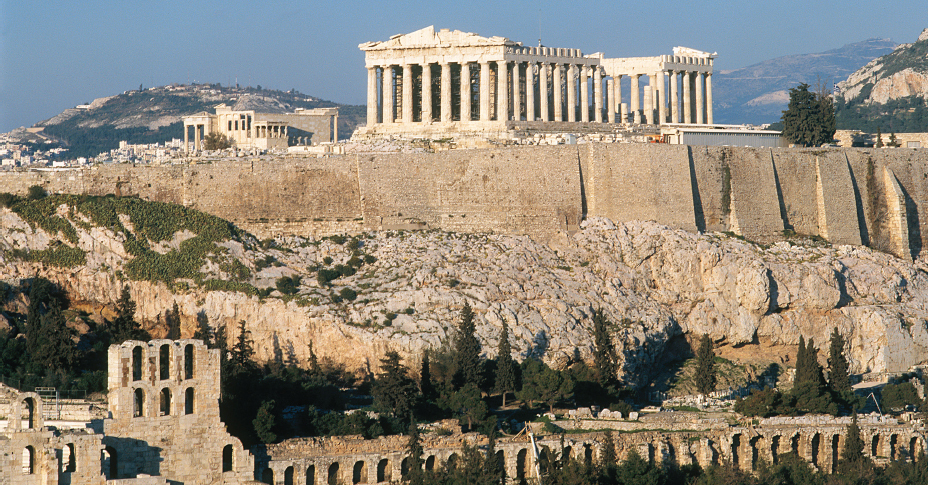Athenian Arts in the Age of Pericles
In the midst of the warfare of the fifth century B.C.E., Pericles turned Athens into the showplace of Greece. He appropriated Delian League money to pay for a huge building program to rebuild the city that had been destroyed during the Persian occupation in 480 B.C.E. and to display to all Greeks the glory of the Athenian polis. The Acropolis in the center of the city was crowned by the Parthenon, a temple that celebrated the greatness of Athens and its patron goddess, Athena, who was represented by a huge statue.

The Acropolis of AthensThe natural rock formation of the Acropolis probably had a palace on top as early as the Mycenaean period, when it was also surrounded by a defensive wall. Temples were constructed beginning in the sixth century B.C.E., and after the Persian wars Pericles ordered the reconstruction and expansion of many of these, as well as the building of new and more magnificent temples and an extension of the defensive walls. The largest building is the Parthenon, a temple dedicated to the goddess Athena, which originally housed a 40-foot-tall statue of Athena made of ivory and gold sheets attached to a wooden frame. Much of the Parthenon was damaged when it was shelled during a war between Venice and the Ottoman Empire in the seventeenth century, and air pollution continues to eat away at the marble. (Marie Mauzy/Art Resource, NY)> PICTURING THE PASTANALYZING THE IMAGE: Imagine yourself as an Athenian walking up the hill toward the Parthenon. What impression would the setting and the building itself convey?CONNECTIONS: What were the various functions of the Acropolis?
Other aspects of Athenian culture were also rooted in the life of the polis. The polis sponsored plays as part of the city’s religious festivals and required wealthy citizens to pay the expenses of their production. Many plays were highly controversial, with overt political and social commentary, but they were neither suppressed nor censored. Not surprisingly, given the incessant warfare, conflict was a constant element in Athenian drama, and playwrights used their art in attempts to portray, understand, and resolve life’s basic conflicts.
Aeschylus (EHS-kuh-luhs) (525–456 B.C.E.) was the first dramatist to explore such basic questions as the rights of the individual, the conflict between the individual and society, and the nature of good and evil. In his trilogy of plays, The Oresteia, he treats the themes of betrayal, murder, and reconciliation, urging the use of reason and justice to reconcile fundamental conflicts.
The plays of Sophocles (SAH-fuh-kleez) (496–406 B.C.E.) also deal with matters personal, political, and divine. In Antigone — which tells of how a king’s mistakes in judgment lead to the suicides of his son, his son’s fiancée, and his wife — Sophocles emphasizes the precedence of divine law over political law and family custom. In Oedipus the King, Sophocles tells the story of a good man doomed by the gods to kill his father and marry his mother. When Oedipus fails to avoid his fate, he blinds himself in despair and flees into exile. In Oedipus at Colonus, Sophocles treats the last days of the broken man, whose patient suffering and uncomplaining piety ultimately win the blessings and honor of the gods.
Euripides (yoo-RIH-puh-deez) (ca. 480–406 B.C.E.) likewise explored the theme of personal conflict within the polis and sounded the depths of the individual. With Euripides drama entered a new and more personal phase. To him the gods mattered far less than people.
Athens also produced writers of comedies, who used humor as political commentary in an effort to suggest and support the best policies for the polis. Best known of the comedians is Aristophanes (eh-ruh-STAH-fuh-neez) (ca. 445–386 B.C.E.), a merciless critic of cranks, quacks, and fools. He used his art of sarcasm to dramatize his ideas on the right conduct of citizens and their leaders for the good of the polis.
